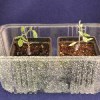 Grafting is a horticultural technology that combines two plants, the scion and the rootsock, to create a plant with desirable features from both parts. In the United States the use of vegetable grafting in field production remains limited, although 70% of the total hydroponic greenhouse tomato area uses grafted seedlings. Large, commercial grafting operations use controlled-environment growth chambers, but the high cost limits their use in most small-scale grafting operations. Healing chambers are an alternative solution that provides proper healing at a lower cost for growers and researchers. This 5-page fact sheet was written by Monica Ozores-Hampton and Aline Coelho Frasca, and published by the UF Department of Horticultural Sciences, October 2013.
Grafting is a horticultural technology that combines two plants, the scion and the rootsock, to create a plant with desirable features from both parts. In the United States the use of vegetable grafting in field production remains limited, although 70% of the total hydroponic greenhouse tomato area uses grafted seedlings. Large, commercial grafting operations use controlled-environment growth chambers, but the high cost limits their use in most small-scale grafting operations. Healing chambers are an alternative solution that provides proper healing at a lower cost for growers and researchers. This 5-page fact sheet was written by Monica Ozores-Hampton and Aline Coelho Frasca, and published by the UF Department of Horticultural Sciences, October 2013.
http://edis.ifas.ufl.edu/hs1232
Tag: Aline Coelho Frasca
Compact Growth Habit Tomatoes
 Alternatives to the traditional production system that reduce production cost would be economically beneficial to the Florida tomato industry. Compact growth habit tomatoes are determinate varieties with a unique architecture that may provide the basis for a viable alternative production system for Florida. These tomatoes have low growth and spreading characteristics, forming compact plants that hold fruit above the ground on short branches. They do not require staking, tying, or pruning, so they may be used by the Florida mature-green fresh-market tomato growers to reduce labor costs. This 5-page fact sheet was written by Monica Ozores-Hampton, Aline Coelho Frasca, John Scott, and Samuel Hutton, and published by the UF Department of Horticultural Sciences, September 2014.
Alternatives to the traditional production system that reduce production cost would be economically beneficial to the Florida tomato industry. Compact growth habit tomatoes are determinate varieties with a unique architecture that may provide the basis for a viable alternative production system for Florida. These tomatoes have low growth and spreading characteristics, forming compact plants that hold fruit above the ground on short branches. They do not require staking, tying, or pruning, so they may be used by the Florida mature-green fresh-market tomato growers to reduce labor costs. This 5-page fact sheet was written by Monica Ozores-Hampton, Aline Coelho Frasca, John Scott, and Samuel Hutton, and published by the UF Department of Horticultural Sciences, September 2014.
http://edis.ifas.ufl.edu/hs1231
Growing Heirloom Tomato Varieties in Southwest Florida (HS921/HS174)
Heirloom tomatoes have seen a rebirth in popularity because of increasing demand for fresh, fully ripe, tasty tomatoes. A tomato must meet three criteria to be considered an heirloom variety: The variety must be reproduced by seed, must have been cultivated for more than 50 years, and must have a history. Heirloom tomatoes are known for their singular taste, shape, and color, which include purple, orange, and yellow, in addition to the common red tomatoes. This 9-page fact sheet was written by Monica Ozores-Hampton, Charles S. Vavrina, and Aline Coelho Frasca, and published by the UF Department of Horticultural Sciences, February 2012.
http://edis.ifas.ufl.edu/hs174